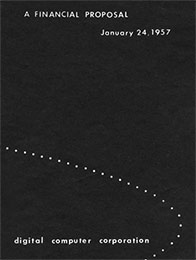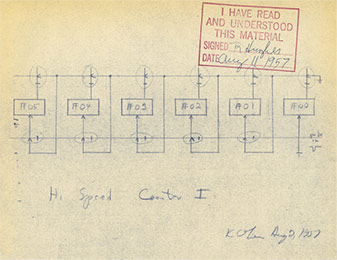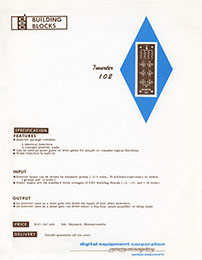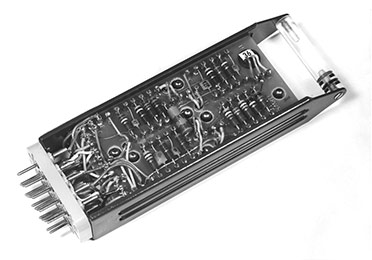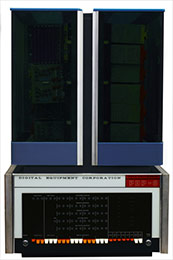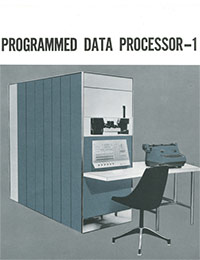- Introduction
- EDUCATION
- INNOVATION & VC
- GLOBAL LEGACY
According to business journalist Udayan Gupta, "[ARD] was an attempt to design a tool that would finance business development, especially in the unchartered waters of high technology–without government involvement."40 In 1957, ARD made an investment in Digital Equipment Corporation (DEC) that would change the course of computer technology.
DEC was the brainchild of Kenneth H. Olsen and Harlan Anderson. A US Navy veteran, Olsen was getting his master's degree at MIT and working with Anderson at the MIT Lincoln Laboratory on a transistor-based computer. Transistors had begun to replace vacuum tubes and represented what was known as the "second generation" of computers able to hold thousands of binary logic circuits within a compact design. Olsen and Anderson joined forces to create a company that would produce these smaller, less expensive machines (in contrast to IBM and Univac mainframes) for business applications. "We felt what we were doing was important and we felt we had to show the world that our computers were practical, inexpensive and reliable," Olsen wrote, "And so we started a company."41
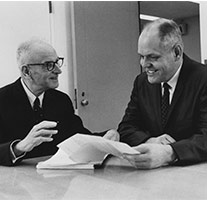
"[Doriot's] investment in Digital Equipment Corporation (DEC) was a daring one, not simply because it was contrarian, but because he saw the investment as a tool for massive economic and technological change."
Udayan Gupta, The First Venture Capitalist: Georges Doriot on Leadership, Capital, & Business Organization, 2004 39
Investors at the time showed little interest in the computer industry. "Venture capitalism itself was a relatively new concept, especially in the nascent computer industry," Glenn Rifkin and George Harrar note in The Ultimate Entrepreneur: The Story of Ken Olsen and Digital Equipment Corporation.42 In January 1957, Olsen and Anderson submitted a four-page, typewritten business proposal to ARD, followed in May by a nine-page proposal.43 ARD offered the two entrepreneurs $70,000 in equity financing for a 70 percent share and an additional loan of $30,000. The team found space in an old mill factory in Maynard, Massachusetts, formerly occupied by the American Woolen Company. In 1958, DEC's first products were computer modules–circuit boards that served as the basic building blocks for computer functions in various technologies. "In those early days, we did everything ourselves," Olsen remembered. "We silk-screened our printed circuit boards with real silk on wooden frames...; [we] made our own tools; we swept the floors."44
In their 1957 plan, Olsen and Anderson outlined the steps toward the creation of a computer whose "capacity and speed would be in excess of computers available today while the price (about $400,000) would be significantly less. Initial models would be well suited for use in scientific computation and control applications... [T]his same basic computer will also be suited for use in business applications."45 In 1962, DEC introduced the PDP-1 (Programmed Data Processor) computer, followed up by a series of PDP models including, in 1965, the PDP-8, considered the first minicomputer. The company entered the high-end computer market with the introduction of the VAX models in the 1970s. Ted Johnson, (HBS MBA ;58), a former student of Doriot's, served as the company's first salesman.
While Xerox, Hewlett-Packard, and other companies made motions to buy DEC, ARD refused. "[ARD] wouldn't buy and sell companies at the first opportunity," Olsen wrote. "The General really preached this and practiced it. It was his contribution. Any other company would have attempted to sell when somebody was doing well and clean up on the profit."46
DEC reigned as the second largest computer company in the world after IBM and the dominant player in the minicomputer industry.47 "[I]t was a sea change in the attitudes toward venture capital investing...," former ARD associate James F. Morgan (HBS MBA '64) asserts. "It was really mind-blowing, that you could take such a small amount of seed capital and get ownership of a company that was worth more than IBM in a fairly short period of time."48 DEC's success in the minicomputer field also inspired the formation of other computer startups and the eventual rise of the personal computer. "[Doriot's] investment in Digital Equipment Corporation... was a daring one," Gupta notes, "not simply because it was contrarian, but because he saw the investment as a tool for massive economic and technological change."49
39
Udayan Gupta, ed. The First Venture Capitalist: Georges Doriot on Leadership, Capital, & Business Organization (Calgary: Gondolier, 2004), xiv.
40
Gupta, ed., First Venture Capitalist, xx.
41
Ken Olsen, "Digital Corporate History," in D.E.C. Celebration Committee, Ken Olsen Day, April 19, 1983, Commemorative Program, 11. GCA.
42
Glenn Rifkin and George Harrar, The Ultimate Entrepreneur: The Story of Ken Olsen and Digital Equipment Corporation (Chicago: Contemporary Books, 1988), 12.
43
Olsen and Anderson made copies of the proposal by producing contact prints from the original. Submitted in reverse, the proposal appeared as white letters on a black background.
44
Olsen, Digital Corporate History, 11.
45
Digital Equipment Corporation, "A Proposal to American Research and Development Corporation 27 May 1957," 4. GCA.
46
Olsen quoted in Ante, 180.
47
See Peter Petre and Alan Farnham, "America's Most Successful Entrepreneur," Fortune, 27 October, 1986: 58. In 1998, Compaq bought out DEC, and in 2002 Hewlett-Packard bought out Compaq.
48
James F. Morgan quoted in Ante, 197.
49
Gupta, ed., First Venture Capitalist, xx.

